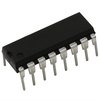-
Part Symbol
-
Footprint
Available Download Formats
By downloading CAD models, you agree to our Terms & Conditions and Privacy Policy

Precision Instrumentation Amplifier
Tip: Data for a part may vary between manufacturers. You can filter for manufacturers on the top of the page next to the part image and part number.
AD524BD by Analog Devices Inc is an Instrumentation Amplifier.
Instrumentation Amplifiers are under the broader part category of Amplifier Circuits.
Amplifier circuits use external power to increase the amplitude of an input signal. They can be used to perform linear amplifications or logarithmic functions. Read more about Amplifier Circuits on our Amplifier Circuits part category page.
| Part # | Distributor | Description | Stock | Price | Buy | |
|---|---|---|---|---|---|---|
|
DISTI #
AD524BD-ND
|
DigiKey | IC INST AMP 1 CIRCUIT 16CDIP Lead time: 10 Weeks Container: Tube | Temporarily Out of Stock |
|
Buy Now | |
|
|
Analog Devices Inc | PRECISION LOW NOISE IN AM Package Multiple: 23 | 1587 |
|
$70.9800 / $123.0700 | Buy Now |
|
|
Bristol Electronics | 2 |
|
RFQ | ||
|
|
Quest Components | IC,INSTRUMENTATION AMPLIFIER,SINGLE,BIPOLAR/JFET,DIP,16PIN,CERAMIC | 4 |
|
$34.4200 | Buy Now |
|
|
Quest Components | IC,INSTRUMENTATION AMPLIFIER,SINGLE,BIPOLAR/JFET,DIP,16PIN,CERAMIC | 3 |
|
$29.4970 | Buy Now |
|
|
Quest Components | IC,INSTRUMENTATION AMPLIFIER,SINGLE,BIPOLAR/JFET,DIP,16PIN,CERAMIC | 3 |
|
$34.4200 | Buy Now |
|
|
Quest Components | IC,INSTRUMENTATION AMPLIFIER,SINGLE,BIPOLAR/JFET,DIP,16PIN,CERAMIC | 1 |
|
$30.3000 | Buy Now |
By downloading CAD models, you agree to our Terms & Conditions and Privacy Policy
|
|
AD524BD
Analog Devices Inc
Buy Now
Datasheet
|
Compare Parts:
AD524BD
Analog Devices Inc
Precision Instrumentation Amplifier
|
| Pbfree Code | No | |
| Rohs Code | No | |
| Part Life Cycle Code | Not Recommended | |
| Ihs Manufacturer | ANALOG DEVICES INC | |
| Part Package Code | DIP | |
| Package Description | DIP-16 | |
| Pin Count | 16 | |
| Manufacturer Package Code | D-16 | |
| Reach Compliance Code | not_compliant | |
| ECCN Code | EAR99 | |
| HTS Code | 8542.31.00.01 | |
| Samacsys Manufacturer | Analog Devices | |
| Amplifier Type | INSTRUMENTATION AMPLIFIER | |
| Average Bias Current-Max (IIB) | 0.025 µA | |
| Bandwidth (3dB)-Nom | 1 MHz | |
| Common-mode Reject Ratio-Min | 75 dB | |
| Input Offset Current-Max (IIO) | 0.015 µA | |
| Input Offset Voltage-Max | 100 µV | |
| JESD-30 Code | R-CDIP-T16 | |
| JESD-609 Code | e0 | |
| Length | 19.05 mm | |
| Neg Supply Voltage Limit-Max | -18 V | |
| Neg Supply Voltage-Nom (Vsup) | -15 V | |
| Non-linearity-Max | 0.01% | |
| Number of Functions | 1 | |
| Number of Terminals | 16 | |
| Operating Temperature-Max | 85 °C | |
| Operating Temperature-Min | -40 °C | |
| Package Body Material | CERAMIC, METAL-SEALED COFIRED | |
| Package Code | DIP | |
| Package Equivalence Code | DIP16,.3 | |
| Package Shape | RECTANGULAR | |
| Package Style | IN-LINE | |
| Qualification Status | Not Qualified | |
| Seated Height-Max | 5.08 mm | |
| Slew Rate-Nom | 5 V/us | |
| Supply Current-Max | 5 mA | |
| Supply Voltage Limit-Max | 18 V | |
| Supply Voltage-Nom (Vsup) | 15 V | |
| Surface Mount | NO | |
| Temperature Grade | INDUSTRIAL | |
| Terminal Finish | Tin/Lead (Sn/Pb) | |
| Terminal Form | THROUGH-HOLE | |
| Terminal Pitch | 2.54 mm | |
| Terminal Position | DUAL | |
| Voltage Gain-Max | 1000 | |
| Voltage Gain-Min | 1 | |
| Voltage Gain-Nom | 10 | |
| Width | 7.62 mm |
The recommended power-up sequence is to apply VDD before applying VLOGIC. This ensures that the internal voltage regulator is powered up correctly.
To ensure that the AD524BD is in a known state after power-up, assert the RESET pin low for at least 100 ns. This initializes the internal registers and sets the output to a known state.
The AD524BD's output can drive up to 1 nF of capacitance. Exceeding this limit may affect the device's stability and performance.
To minimize noise and interference, use a low-pass filter on the input, keep the input traces short and away from noise sources, and use a ground plane to reduce electromagnetic interference.
The thermal impedance of the AD524BD package is typically around 30°C/W. This value can be used to estimate the junction temperature of the device.